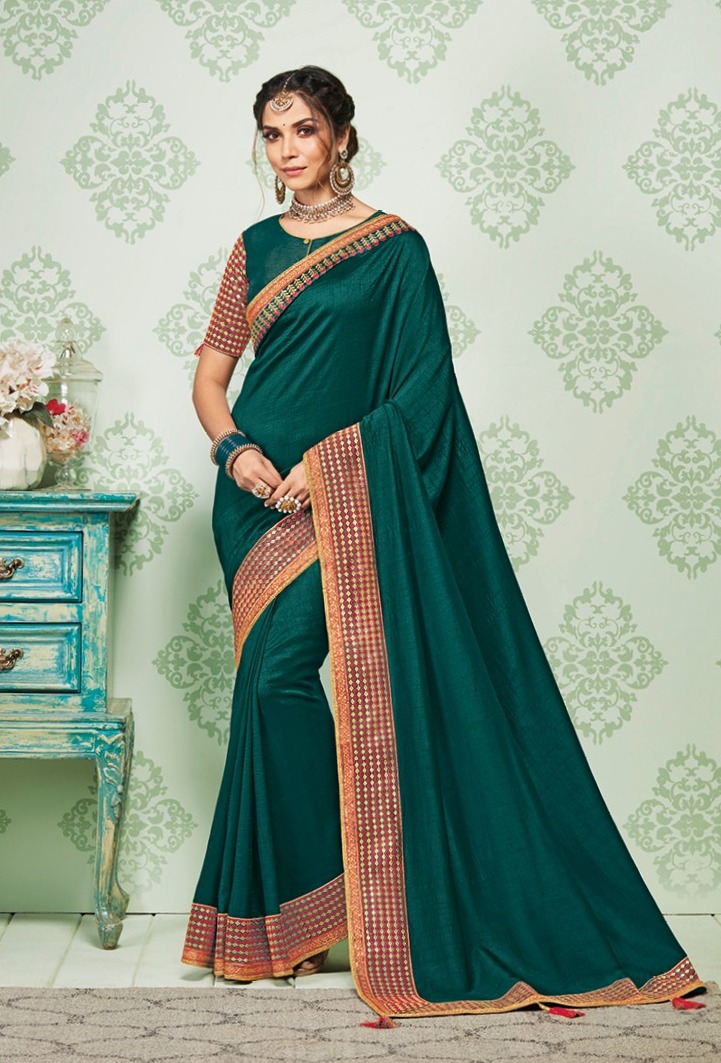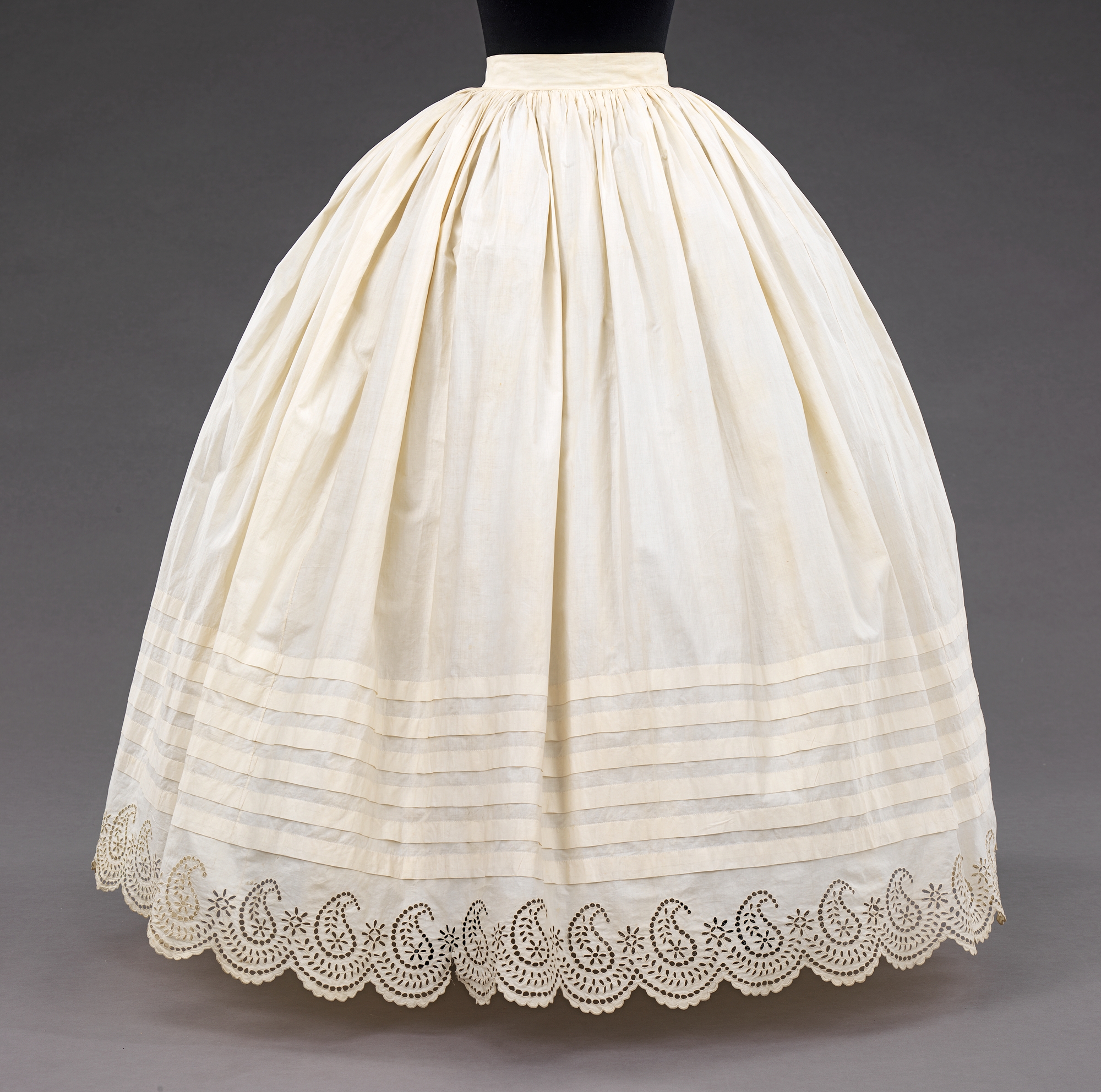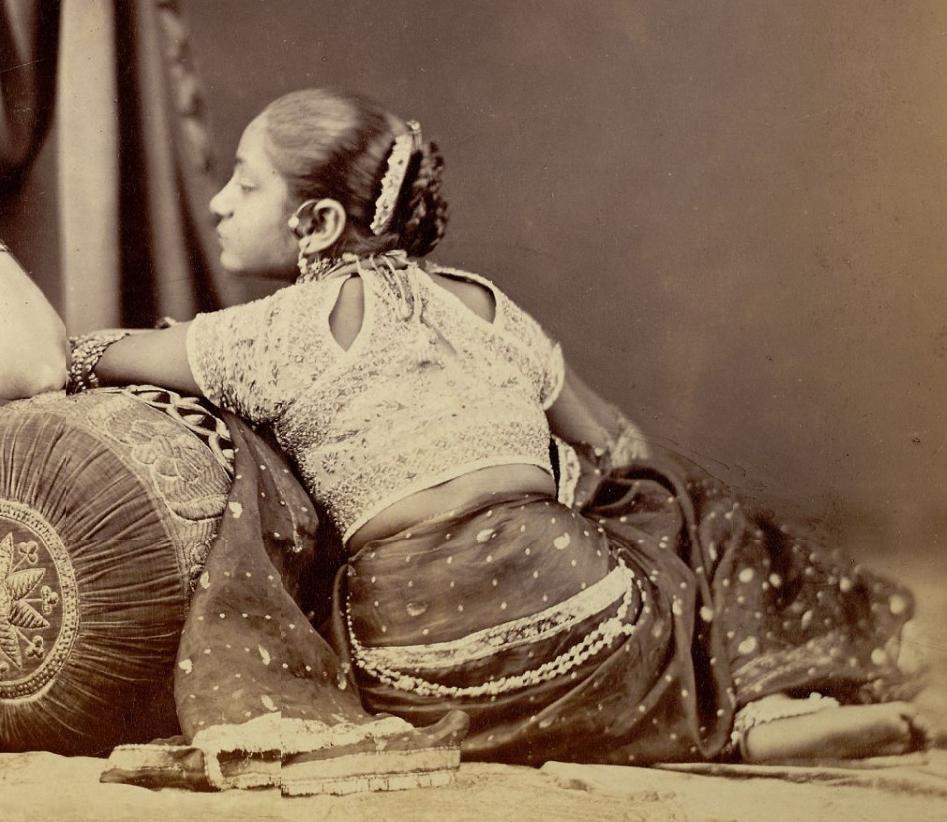|
Saree
A sari (also called sharee, saree or sadi)The name of the garment in various regional languages include: * * * * * * * * * * * * * * is a drape (cloth) and a women's garment in the Indian subcontinent. It consists of an un-stitched stretch of woven fabric arranged over the body as a dress, with one end attached to the waist, while the other end rests over one shoulder as a stole, sometimes baring a part of the midriff.Alkazi, Roshan (1983) "Ancient Indian costume", Art HeritageGhurye (1951) "Indian costume", Popular book depot (Bombay); (Includes rare photographs of 19th century Namboothiri and nair women in ancient sari with bare upper torso) It may vary from in length, and in breadth, and is a form of ethnic wear in Bangladesh, India, Sri Lanka, Nepal, and Pakistan. There are various names and styles of sari manufacture and draping, the most common being the Nivi (meaning new) style.Linda Lynton(1995), The Sari: Styles, Patterns, History, Technique , page ... [...More Info...] [...Related Items...] OR: [Wikipedia] [Google] [Baidu] |
Ghagra Choli
Ghagra choli (also known as lehenga choli and chaniya choli) is a type of ethnic clothing for women from India, notably in the Indian states of Rajasthan, Gujarat, Madhya Pradesh, Uttar Pradesh, Bihar, Haryana, Punjab, Himachal Pradesh, Uttarakhand, Jammu and Kashmir and southern Nepal in Terai plains. In Punjab, the ''lehenga'' is traditionally worn with a kurti. It is a combination of the ''ghagra'' or ''lehenga'' (long skirt) and the '' choli'' (blouse). In contemporary and modern usage ''lehenga choli'' is the widely used term by fashion designers, trend setters, and boutiques in India, since ''ghagra'' is synonymous with the half-slip (petticoat) worn as an undergarment below the sari. Terms and history Historically, the gagra choli evolved from the three-piece attire worn by women in ancient India. The attire consisted of the '' antriya'' lower garment, the '' uttariya'' veil worn over the shoulder or head and ''stanapatta'' a chest band, which is mentioned in Sanskr ... [...More Info...] [...Related Items...] OR: [Wikipedia] [Google] [Baidu] |
Petticoat
A petticoat or underskirt is an article of clothing, a type of undergarment worn under a skirt or a dress. Its precise meaning varies over centuries and between countries. According to the ''Oxford English Dictionary'', in current British English, a petticoat is "a light loose undergarment ... hanging from the shoulders or waist". In modern American usage, "petticoat" refers only to a garment hanging from the waist. They are most often made of cotton, silk or tulle. Without petticoats, skirts of the 1850s would not have the volume they were known for. In historical contexts (16th to mid-19th centuries), ''petticoat'' refers to any separate skirt worn with a gown, bedgown, bodice or jacket; these petticoats are not, strictly speaking, underwear, as they were made to be seen. In both historical and modern contexts, ''petticoat'' refers to skirt-like undergarments worn for warmth or to give the skirt or dress the desired attractive shape. Terminology Sometimes a petticoat ... [...More Info...] [...Related Items...] OR: [Wikipedia] [Google] [Baidu] |
Ethnic Wear
Folk costume, traditional dress, traditional attire or folk attire, is clothing of an ethnic group, nation or region, and expresses cultural, religious or national identity. An ethnic group's clothing may also be called ethnic clothing or ethnic dress. Traditional clothing includes everyday and formal wear. The word "costume" in this context is sometimes considered pejorative, as the word has more than one meaning, and thus "clothing", "dress", "attire" or "regalia" can be substituted without offense. Following the rise of romantic nationalism in parts of Europe, pre-industrial peasantry came to serve as ideals for genuinity and desirability. Garments evoking peasant dress were made from traditional pre-industrial textiles. In regions where Western dress styles are common, traditional garments are often worn during special events or celebrations. International events may cater to non-Western attendees with a compound dress code such as "business suit or national dress". In s ... [...More Info...] [...Related Items...] OR: [Wikipedia] [Google] [Baidu] |
Midriff
In fashion, the midriff is the human abdomen. The midriff is exposed when wearing a crop top or some forms of swimwear or underwear. Etymology "Midriff" is a very old term in the English language, coming into use before 1000 AD. In Old English it was written as "", with the old word "" literally meaning stomach; in Middle English, it was "". The word fell into obsolescence after the 18th century. The word was revived in 1941 by the fashion industry, partly to avoid use of the word "belly" which genteel women considered undesirable in reference to their bodies, as it has connotations of obesity. Culture and history Western culture 1930s–1970s In some cultures, exposure of the midriff is socially discouraged or even banned, and Western culture has historically been hesitant in the use of midriff-baring styles. Bill Blass commented: It is too difficult. Women will much more readily wear bare-back or plunging-neckline styles. It was introduced to fashion in 1932 b ... [...More Info...] [...Related Items...] OR: [Wikipedia] [Google] [Baidu] |
Nepal
Nepal, officially the Federal Democratic Republic of Nepal, is a landlocked country in South Asia. It is mainly situated in the Himalayas, but also includes parts of the Indo-Gangetic Plain. It borders the Tibet Autonomous Region of China China–Nepal border, to the north, and India India–Nepal border, to the south, east, and west, while it is narrowly separated from Bangladesh by the Siliguri Corridor, and from Bhutan by the States and union territories of India, Indian state of Sikkim. Nepal has a Geography of Nepal, diverse geography, including Terai, fertile plains, subalpine forested hills, and eight of the world's ten List of highest mountains#List, tallest mountains, including Mount Everest, the highest point on Earth. Kathmandu is the nation's capital and List of cities in Nepal, its largest city. Nepal is a multi-ethnic, multi-lingual, multi-religious, and multi-cultural state, with Nepali language, Nepali as the official language. The name "Nepal" is first record ... [...More Info...] [...Related Items...] OR: [Wikipedia] [Google] [Baidu] |
Choli
A choli or ravike in South India is a blouse or a bodice-like upper garment, that is usually cut short or cropped leaving the midriff bare. It is worn along with a sari in the Indian subcontinent. In northern Gujarat is also known as ''polku''. The choli is also part of the ghagra choli costume in the Indian subcontinent. Women of Rajput families wore the kurti on top of the choli, because the choli left the midriff & the back bare. Evolution The choli evolved from the ancient '' stanapatta'', also known as ''kurpsika'' or '' kanchuki'', which was one of the forms of three-piece attire worn by women during the ancient period. This consisted of the '' antriya'' lower garment; the '' uttariya'' veil worn over shoulder or head; and the ''stanapatta,'' a chest band, which is mentioned in Sanskrit literature and Buddhist Pali literature during the 6th century BC. Paintings from Maharashtra and Gujarat from the first millennium BCE are considered the first recorded examples o ... [...More Info...] [...Related Items...] OR: [Wikipedia] [Google] [Baidu] |
Hinduism Today
''Hinduism Today'' is a quarterly magazine published by the Himalayan Academy, a nonprofit educational institution, in Kapaʻa, Hawaiʻi, USA. It is distributed throughout the United States and internationally, currently in 60 nations. Founded by Sivaya Subramuniyaswami in 1979, it is a public service of his monastic order to promote an understanding of the Hindu faith, culture, and traditions. History and topics ''Hinduism Today'' was launched in 1979 by Sivaya Subramuniyaswami (Gurudeva), published by his non-profit organization Himalayan Academy. The magazine was originally known as ''The New Saivite World'', a small black-and-white periodical without a fixed publication schedule. The first issue appeared February 1979, with the goal of giving a voice to Gurudeva's worldwide fellowship in a way that was easy to read, simple to produce, mail and handle. The newsletter was to be a people-oriented paper, not so much devoted to philosophy or teaching since the Himalayan Academy wa ... [...More Info...] [...Related Items...] OR: [Wikipedia] [Google] [Baidu] |
Hindi
Modern Standard Hindi (, ), commonly referred to as Hindi, is the Standard language, standardised variety of the Hindustani language written in the Devanagari script. It is an official language of India, official language of the Government of India, alongside English language, English, and is the ''lingua franca'' of North India. Hindi is considered a Sanskritisation (linguistics), Sanskritised Register (sociolinguistics), register of Hindustani. Hindustani itself developed from Old Hindi and was spoken in Delhi and neighbouring areas. It incorporated a significant number of Persian language, Persian loanwords. Hindi is an Languages with official status in India, official language in twelve states (Bihar, Gujarat , Mizoram , Maharashtra ,Chhattisgarh, Haryana, Himachal Pradesh, Jharkhand, Madhya Pradesh, Rajasthan, Uttar Pradesh, Uttarakhand), and six Union territory, union territories (Andaman and Nicobar Islands, Delhi, Chandigarh, Dadra and Nagar Haveli and Daman and Di ... [...More Info...] [...Related Items...] OR: [Wikipedia] [Google] [Baidu] |
Sanskrit
Sanskrit (; stem form ; nominal singular , ,) is a classical language belonging to the Indo-Aryan languages, Indo-Aryan branch of the Indo-European languages. It arose in northwest South Asia after its predecessor languages had Trans-cultural diffusion, diffused there from the northwest in the late Bronze Age#South Asia, Bronze Age. Sanskrit is the sacred language of Hinduism, the language of classical Hindu philosophy, and of historical texts of Buddhism and Jainism. It was a lingua franca, link language in ancient and medieval South Asia, and upon transmission of Hindu and Buddhist culture to Southeast Asia, East Asia and Central Asia in the early medieval era, it became a language of religion and high culture, and of the political elites in some of these regions. As a result, Sanskrit had a lasting effect on the languages of South Asia, Southeast Asia and East Asia, especially in their formal and learned vocabularies. Sanskrit generally connotes several Indo-Aryan languages# ... [...More Info...] [...Related Items...] OR: [Wikipedia] [Google] [Baidu] |
Surat Sarees
Surat (Gujarati Language, Gujarati: ) is a city in the western Indian States and territories of India, state of Gujarat. The word Surat directly translates to ''face'' in Urdu, Gujarati language, Gujarati and Hindi. Located on the banks of the river Tapti near its confluence with the Arabian Sea, it used to be a large seaport. It is now the commercial and economic centre of South Gujarat, and one of the largest urban areas of western India. It has well-established diamond and textile industry, and is a major supply centre for apparels and accessories. About 90% of the world's diamonds are cut and polished in Surat. It is the second largest city in Gujarat after Ahmedabad and the List of most populous cities in India, eighth largest city by population and List of million-plus urban agglomerations in India, ninth largest urban agglomeration in India. It is the administrative capital of the Surat district. The city is located south of the state capital, Gandhinagar; south of A ... [...More Info...] [...Related Items...] OR: [Wikipedia] [Google] [Baidu] |
Kannada
Kannada () is a Dravidian language spoken predominantly in the state of Karnataka in southwestern India, and spoken by a minority of the population in all neighbouring states. It has 44 million native speakers, and is additionally a second or third language for 15 million speakers in Karnataka. It is the official and administrative language of Karnataka. It also has scheduled status in India and has been included among the country's designated classical languages.Kuiper (2011), p. 74R Zydenbos in Cushman S, Cavanagh C, Ramazani J, Rouzer P, ''The Princeton Encyclopedia of Poetry and Poetics: Fourth Edition'', p. 767, Princeton University Press, 2012, Kannada was the court language of a number of dynasties and empires of South India, Central India and the Deccan Plateau, namely the Kadamba dynasty, Western Ganga dynasty, Nolamba dynasty, Chalukya dynasty, Rashtrakutas, Western Chalukya Empire, Seuna dynasty, kingdom of Mysore, Nayakas of Keladi, Ho ... [...More Info...] [...Related Items...] OR: [Wikipedia] [Google] [Baidu] |
Dharmic
Dharma (; , ) is a key concept in various Indian religions. The term ''dharma'' does not have a single, clear translation and conveys a multifaceted idea. Etymologically, it comes from the Sanskrit ''dhr-'', meaning ''to hold'' or ''to support'', thus referring to law that sustains things—from one's life to society, and to the Universe at large. In its most commonly used sense, dharma refers to an individual's moral responsibilities or duties; the dharma of a farmer differs from the dharma of a soldier, thus making the concept of dharma a varying dynamic. As with the other components of the Puruṣārtha, the concept of ''dharma'' is pan-Indian. The antonym of dharma is ''adharma''. In Hinduism, ''dharma'' denotes behaviour that is considered to be in accord with ''Ṛta''—the "order and custom" that makes life and universe possible. This includes duties, rights, laws, conduct, virtues and "right way of living" according to the stage of life or social position. ''Dharma'' is ... [...More Info...] [...Related Items...] OR: [Wikipedia] [Google] [Baidu] |








